In Power Point Can You Enlarge an Item Until You Click Again
Lesson 18: Aligning, Ordering, and Grouping Objects
/en/powerpoint/shapes/content/
Introduction
In PowerPoint, each slide may have multiple items, such as pictures, shapes, and text boxes. You can arrange the objects the way you desire past aligning, ordering, grouping, and rotating them in various ways.
Optional: Download our practice presentation.
Watch the video beneath to larn more about adjustment, ordering, and grouping objects in PowerPoint.
Aligning objects
When you motion objects in PowerPoint, alignment guides and spacing guides volition appear as dashed orange lines and arrows around the objects to help you align them. However, if y'all have several objects on a slide, information technology may be difficult and time consuming to become them perfectly aligned. Luckily, PowerPoint has several alignment commands that let you to easily arrange and position objects.

To align 2 or more than objects:
- Select the objects you want to marshal. To select multiple objects at once, hold the Shift key while yous click. The Format tab volition appear.

- From the Format tab, click the Marshal command, then select Marshal Selected Objects.
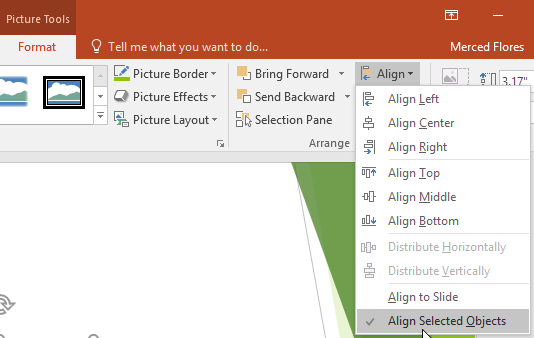
- Click the Align command again, then select one of the six alignment options.
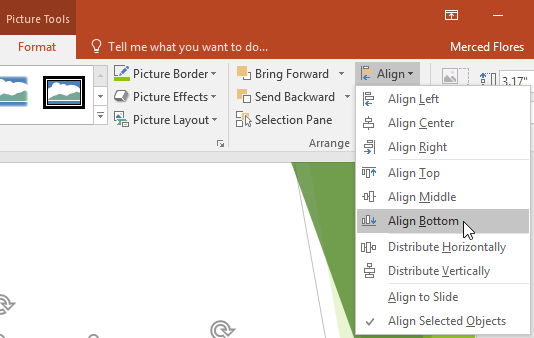
- The objects will align based on the option you selected.

To marshal objects to the slide:
Sometimes you may want to align one or more objects to a specific location inside the slide, such equally at the top or bottom. You can practise this by selecting the Marshal to Slide option before aligning the objects.
- Select the objects you lot want to align. To select multiple objects at once, hold the Shift key while you lot click.

- From the Format tab, click the Align control, so select Marshal to Slide.
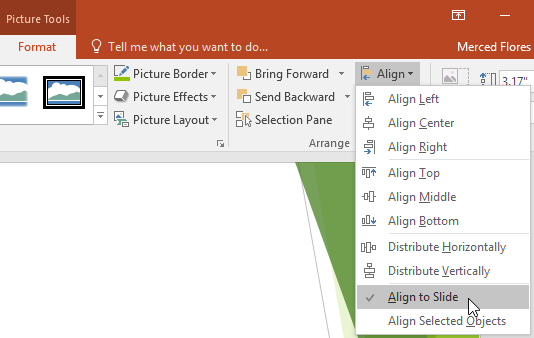
- Click the Align command once more, then select one of the vi alignment options.
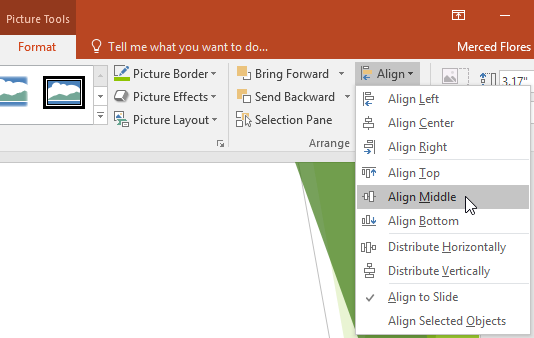
- The objects will align based on the option yous selected.

To distribute objects evenly:
If you have arranged objects in a row or column, you may want them to be an equal distance from one another for a neater appearance. Yous tin can practise this by distributing the objects horizontally or vertically.
- Select the objects you want to align. To select multiple objects at in one case, agree the Shift key while you click.
- From the Format tab, click the Align command, then select Align to Slide or Align Selected Objects.
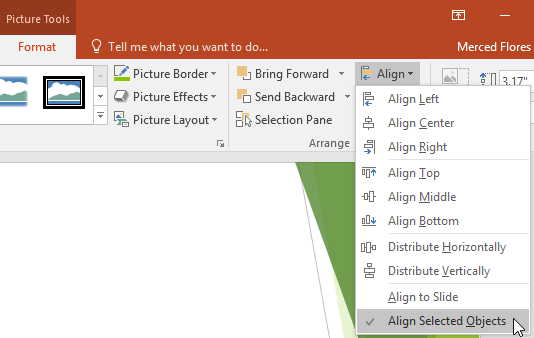
- Click the Marshal control over again, then select Distribute Horizontally or Distribute Vertically from the drop-down bill of fare that appears.
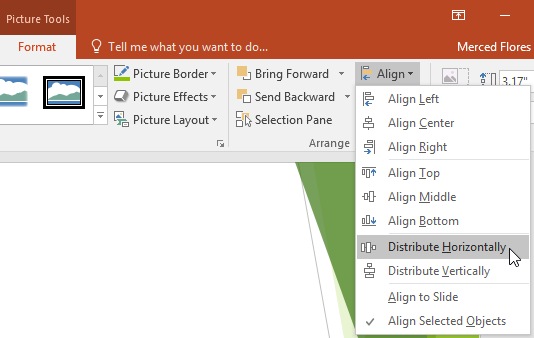
- The objects will distribute evenly.

Grouping objects
You may want to group multiple objects into one object then they will stay together if they are moved or resized. This is often easier than selecting all of the objects each time you lot want to move them.
Pictures, shapes, clip art, and text boxes tin all be grouped; nonetheless, placeholders cannot be grouped. If you will be grouping pictures, apply i of the commands in the Images group on the Insert tab to insert pictures instead of the picture icon inside the placeholder.

To group objects:
- Select the objects you desire to align. To select multiple objects at once, hold the Shift key while yous click. The Format tab will announced.

- From the Format tab, click the Group command, then select Group.
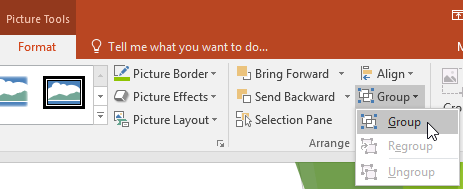
- The selected objects will now exist grouped. There will be a single box with sizing handles around the unabridged grouping to show that they are ane group. You can now move or resize all of the objects at once.

If you want to edit or move i of the objects in the grouping, double-click to select the object. You lot can then edit it or motion it to the desired location.
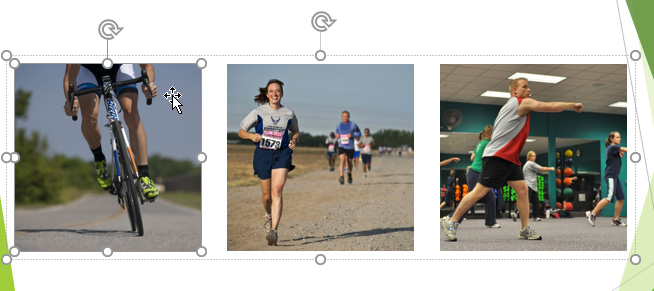
If you lot select the objects and the Grouping control is disabled, it may be considering one of the objects is inside a placeholder. If this happens, endeavor reinserting the images by using the Pictures control on the Insert tab.

To ungroup objects:
- Select the object group you lot desire to ungroup.
- From the Format tab, click the Group command, and so select Ungroup.
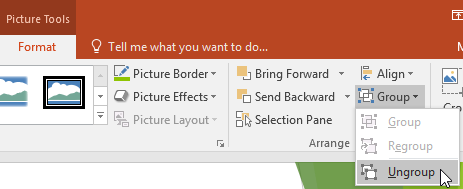
- The objects will exist ungrouped.

Ordering objects
In addition to aligning objects, PowerPoint gives you the power to arrange objects in a specific lodge. The ordering is important when ii or more objects overlap because information technology volition determine which objects are in the front end or the back.
Understanding levels
When objects are inserted into a slide, they are placed on levels according to the order in which they were inserted into the slide. In our example, we've drawn an arrow on the height level, only nosotros can change the level to put it behind the other objects.
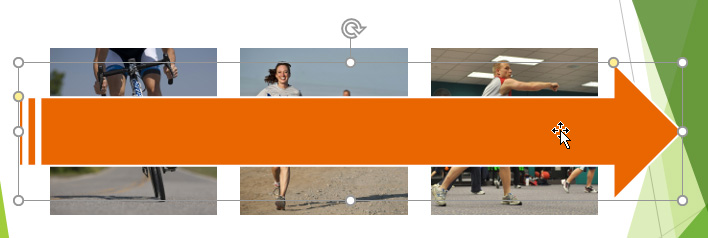
To change the ordering by i level:
- Select an object. The Format tab will appear.

- From the Format tab, click the Bring Forwards or Send Backward command to modify the object's ordering by one level. If there are multiple objects on the slide, you may need to click the control several times to achieve the desired ordering.

- The objects will reorder.

To bring an object to the front or dorsum:
If yous want to movement an object behind or in front end of several objects, it's usually faster to bring it to front or send it to dorsum instead of clicking the ordering commands multiple times.
- Select an object.
- From the Format tab, click the Bring Forwards or Send Backward drop-downwardly arrow.
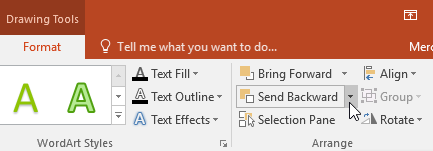
- From the drop-downwards menu, select Bring to Front or Transport to Back.
- The objects will reorder.

If you lot accept several objects placed on top of each other, information technology may be difficult to select an individual object. The Pick pane allows you to hands drag an object to a new location. To access the Selection pane, click Selection Pane on the Format Tab.
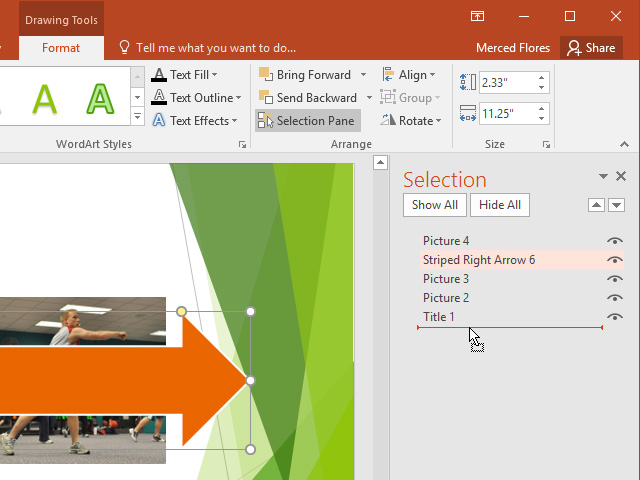
Rotating objects
If you need to turn an object and then it faces a different management, you can rotate it to the left or right or flip it horizontally or vertically.
To rotate an object:
- Select an object. The Format tab will appear.

- From the Format tab, click the Rotate command. A driblet-down menu will appear.
- Select the desired rotation pick.
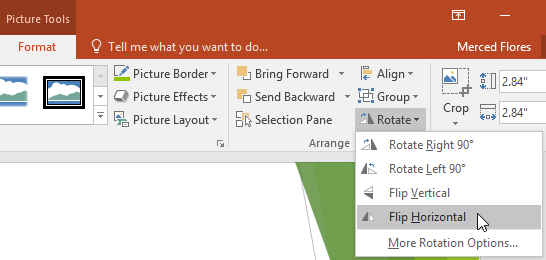
- The object will rotate.

Challenge!
- Open up our practice presentation.
- On the last slide, select the picture of the hamburger and Rotate Left 90°.
- Concord down the Shift key and select all three food pictures. Make sure you do not select the light-green diamonds.
- Check Align to Slide under the Align command, so Align to Middle.
- With the pictures still selected, Distribute Horizontally.
- Select the first greenish diamond and send it backside the breakfast flick.
- When yous're finished, your slide should look like this:

/en/powerpoint/animating-text-and-objects/content/
Source: https://edu.gcfglobal.org/en/powerpoint/aligning-ordering-and-grouping-objects/1/

0 Response to "In Power Point Can You Enlarge an Item Until You Click Again"
Post a Comment